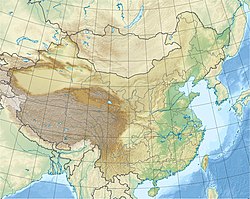The Miaogou Formation is a geological formation in Inner Mongolia, north China. While its absolute age is uncertain, it has been estimated to represent Early Cretaceous (around Aptian–Albian) sediments based on the faunal composition. Dinosaur remains are among the fossils that have been recovered from the formation.
| Miaogou Formation | |
|---|---|
| Stratigraphic range: late Early Cretaceous, | |
| Type | Geological formation |
| Unit of | Yangtaiwatan Basin[1] |
| Underlies | Baiyanghe Formation[2] |
| Lithology | |
| Primary | Sandstone, mudstone, muddy limestone and sandy conglomerate[1] |
| Location | |
| Coordinates | 40°12′N 105°44′E / 40.200°N 105.733°E |
| Region | Inner Mongolia |
| Country | |
History
editThe primary fossil-producing outcrop of the Miaogou Formation is the Maortu locality, which was discovered in 1959 by a joint expedition of Chinese and Russian paleontologists.[3] Initial reports of the locality's fauna incorrectly assigned the fossils to either the Ulansuhai or Dashuigou formations, but a later discussion corrected this.[4]
Paleoenvironment
editAnalysis of the formation's geology indicates that it represents a hot, humid environment with large lake systems.[3] The formation's lower member preserves alluvial fan to braided stream deposits, while the upper member preserves meandering stream and lacustrine deposits.[5]
Fossil content
editColor key
|
Notes Uncertain or tentative taxa are in small text; |
Dinosaurs
edit| Genus | Species | Region | Material | Notes | Images |
|---|---|---|---|---|---|
|
G. domoculus |
Maortu locality, Chilantai |
A skull, with undescribed postcranial remains belonging to the same individual[6] |
An ankylosaurid closely related to Shamosaurus; originally interpreted as from the nearby Ulansuhai Formation[4] |
||
|
P. gobiensis |
Maortu locality, Chilantai |
Partial skulls and skeletons[7] |
A hadrosauroid ornithopod; originally interpreted as from the nearby Dashuigou Formation[4] |
||
|
S. maortuensis |
Maortu locality, Chilantai |
Partial skull, axis, and caudal vertebrae[8] |
A carcharodontosaurid theropod, formerly "Chilantaisaurus" maortuensis; originally interpreted as from the nearby Ulansuhai Formation[4] |
||
|
Y. bainian |
Maortu locality, Chilantai |
Two associated partial skeletons of similarly sized individuals[4] |
A basal oviraptorosaurian theropod |
See also
editReferences
edit- ^ a b Zhang, Shuai; Liu, Lihui; Liu, Qinfu; Zhang, Bingjie; Qiao, Zhichuan; Teppen, Brian J. (February 2021). "Genesis of Palygorskite in the Neogene Baiyanghe Formation in Yangtaiwatan Basin, Northwest China, Based on the Mineralogical Characteristics and Occurrence of Enriched Trace Elements and Ree". Clays and Clay Minerals. 69 (1): 23–37. doi:10.1007/s42860-020-00104-7. ISSN 0009-8604.
- ^ Liu, Lihui; Zhang, Shuai; Liu, Qinfu; Liu, Linsong; Deng, Youjun (September 2021). "Palaeoclimate, palaeosalinity and redox conditions control palygorskite claystone formation: an example from the Yangtaiwatan Basin, northwest China". Clay Minerals. 56 (3): 210–221. doi:10.1180/clm.2022.1. ISSN 0009-8558.
- ^ a b Kliebanova, I. M. (1963). "阿拉善地区(毛尔图)白堊纪恐龙的埋藏" [Deposit of Mesozoic Dinosaurs in Alashan (Maortu)] (PDF). Vertebrata PalAsiatica (in Chinese). 7 (1): 52–58. doi:10.19615/j.cnki.1000-3118.1963.01.005.
- ^ a b c d e Hao, Mingze; Li, Zhiyu; Wang, Zhili; Wang, Shuqiong; Ma, Feimin; Qinggele; King, J. Logan; Pei, Rui; Zhao, Qi; Xu, Xing (2024-10-24). "A new oviraptorosaur from the Lower Cretaceous Miaogou Formation of western Inner Mongolia, China". Cretaceous Research (in press): 106023. doi:10.1016/j.cretres.2024.106023.
- ^ Wang, Zheng Qi; Guan, Tai Yang (2004). "Uranium pre-concentration in Miaogou Formation, Lower Cretaceous and its prospecting significance in Chaoshui Basin". Uranium Geology (in Chinese). 20 (5): 279–285.
- ^ Vickaryous, Matthew K; Russell, Anthony P; Currie, Philip J; Zhao, Xi-Jin (2001-12-01). "A new ankylosaurid (Dinosauria: Ankylosauria) from the Lower Cretaceous of China, with comments on ankylosaurian relationships". Canadian Journal of Earth Sciences. 38 (12): 1767–1780. doi:10.1139/e01-051. ISSN 0008-4077.
- ^ Norman, David B. (2002-08-21). "On Asian ornithopods (Dinosauria: Ornithischia). 4. Probactrosaurus Rozhdestvensky, 1966". Zoological Journal of the Linnean Society. 136 (1): 113–144. doi:10.1046/j.1096-3642.2002.00027.x. ISSN 1096-3642.
- ^ Brusatte, S.; Benson, R.; Chure, D.; Xu, X.; Sullivan, C.; Hone, D. (2009). "The first definitive carcharodontosaurid (Dinosauria: Theropoda) from Asia and the delayed ascent of tyrannosaurids". Naturwissenschaften. 96 (9): 1051–1058. Bibcode:2009NW.....96.1051B. doi:10.1007/s00114-009-0565-2. hdl:20.500.11820/33528c2e-0c9c-4160-8693-984f077ee5d0. PMID 19488730. S2CID 25532873.

